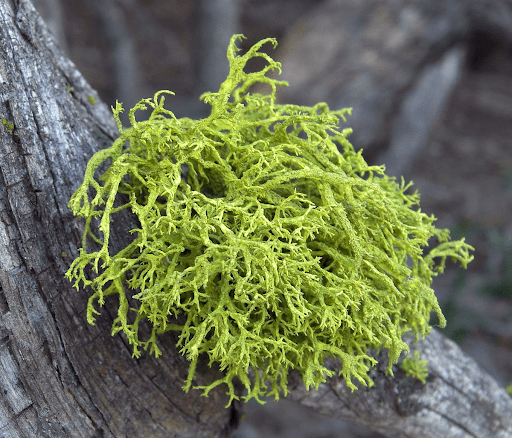Which creature is a combination of two other organisms, comes in bright colors, and helps us measure air quality?
Lichen!

Master of Symbiosis
Though we know lichens as creatures in and of themselves, lichens are actually a result of symbiosis, a mutually beneficial relationship between two or more species. In the lichen’s case, algae and fungi come together to form a new creature. No two lichens are alike. They vary in form, color, and which type of algae they have – either green, blue-green, or both.
The fungus gives the lichen a majority of its traits, including shape and anatomy. The algae determines the color, from orange to yellow to neon green. The fungus partners with the algae out of necessity for food. Since the algae, or cyanobacteria, can photosynthesize, they provide food for the fungus in exchange for shelter. Therefore, each party relies on the other for survival.

Abundant yet Unique
From hot deserts and windy coastlines to the arctic tundra, lichen are found around the world. In North America alone, there are thought to be 3600 different species! They grow on trees, rocks, and soil. They can even grow on things made out of one of the above, such as a house made out of wood. If a sand dune remains stable for long enough, soil crusts will form and lichens will begin to appear along the crusts. Essentially, all lichens need is something solid to hang onto.
Lichens require a stable habitat because they take a long time to grow. Every year, they only grow 1-2 mm. To promote their growth cycle, lichens will often partner with moss, adding yet another organism to the party. Mosses are simple plants (meaning they lack roots, stems, and leaves) that retain water, and since lichens have two creatures to sustain (the algae and fungi), this water source is a welcomed one. This partnership is so common that if you look up ‘lichen’ on the internet, a majority of pictures will contain both lichen and moss. They are truly geniuses of cooperation!

Welcomed by All
At first glance, it may look like lichens harm trees. (After all, if you or I had something bright green or orange growing on our limbs, we should call the doctor). But fear not – lichens don’t harm any plants they attach themselves to. On the contrary, they benefit many other species, such as birds that use lichen as nesting material. Numerous invertebrates see lichen as a source for food and shelter and, as a result, the more lichen in a forest, the more organisms the ecosystem can sustain.
Humans have reaped the benefits of lichen, too. We have used them for clothing, decorations, and food. They are also highly valued for their antibiotic properties. Today, we use them in toothpastes, salves, deodorants, and other products. So you can thank lichens for helping us stay clean and healthy!
A Climate Helper
Since the algae in lichen photosynthesize, lichens contribute to the important function of converting carbon dioxide in the atmosphere to oxygen. The fungus in lichen contribute to this function, too, by allowing algae to live in places they wouldn’t be able to on their own. By providing a form of shelter, the fungus gives an opportunity for more algae to exist and thrive, and that means we have more creatures sequestering carbon and stabilizing the climate.
Lichens also play a vital role in soil formation and development by helping to break down solid minerals like rock. This process creates pockets in the soil – perfect for larger organisms to thrive in. It also creates pathways for nutrients to sink deep into the Earth, where they will later benefit plants and other creatures. As we like to say at Bio4Climate, healthy soil makes for a healthy planet.
Last but not least, lichens give us an insight on the amount of pollution in their respective area. Lichens absorb everything around them – including air, nutrients, water, and pollutants. Scientists study lichens in order to understand the type of toxins present in the environment and their levels. This information gives us insights on the root causes of disease and environmental degradation. With that knowledge, we can address issues affecting human and wildlife communities – creating a cleaner environment for us all.
That’s all for now, but I hope you’re lichen this series!
Tania

Tania graduated from Tufts University with a Master of Science in Animals and Public Policy. Her academic research projects focused on wildlife conservation efforts, and the impacts that human activities have on wild habitats. As a writer and activist, Tania emphasizes the connections between planet, human, and animal health. She is a co-founder of the podcast Closing the Gap, and works on outreach and communications for Sustainable Harvest International. She loves hiking, snorkeling, and advocating for social justice.
Sources:
https://www.deschuteslandtrust.org/news/blog/2016-blog-posts/five-fun-facts-about-lichen
https://www.fs.fed.us/wildflowers/beauty/lichens/about.shtml
https://www.woodlandtrust.org.uk/blog/2019/04/what-is-lichen-seven-types-of-lichen-found-on-trees/
https://digitalcommons.humboldt.edu/cgi/viewcontent.cgi?article=1078&context=ideafest

